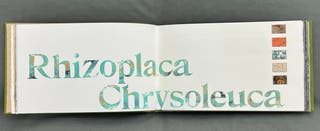New Acquisition—Lichen: Rambles in the Colorado Front Range
Fine press and artists’ books are growing strengths of the Linda Hall Library History of Science collection. When books artists respond to science, engineering, technology, and their histories, they contribute to a rich tapestry of knowledge about the natural world. Their books illuminate the human worlds through which scientific work happens. They explore visual representations of nature in 16th and 17th century India and the life and work of female astronomers and imagine encounters between botanical artists concerned with detail and beauty. The authors also go on explorations not too far from Missouri, with eyes peeled for the small and often-missed species that live all around us.
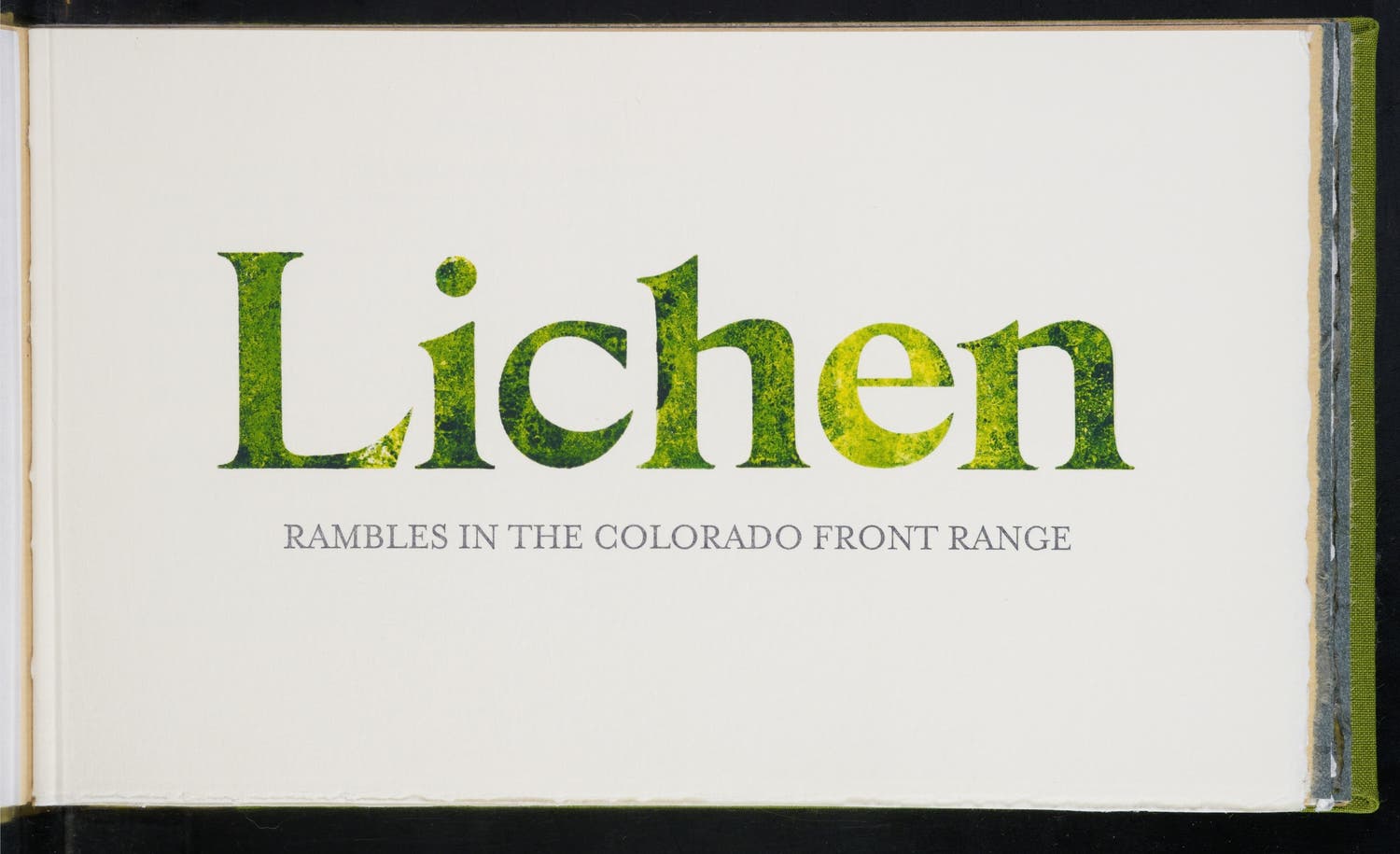
The title page of Lichen: Rambles in the Colorado Front Range, by Rhiannon Alpers. The title is mono-printed with wood type and alternative ink processes. Each copy has a unique pattern.
Lichen: Rambles in the Colorado Front Range is written, designed, printed, and bound by the book artist Rhiannon Alpers. In late 2024, the Library acquired a copy directly from Alpers’ Gazelle and Goat Press in Denver, Colorado.
The book is a visual and tactile exploration of two lichen and one moss. Alpers collages maps, scientific names, watercolor swatches, and narratives about her research. She aimed to integrate the scientific names of the species into the story. In her words, she was “highlighting their physical characteristics as well as their botanical significance.”
The book sits within a larger box containing small samples of lichen and moss preserved in glass vials and a magnification loupe for the viewer. The box also contains a copy of Alpers’ earlier book FieldWork, a small accordion book that unfolds to reveal biographies of four women naturalists of the 1900s.
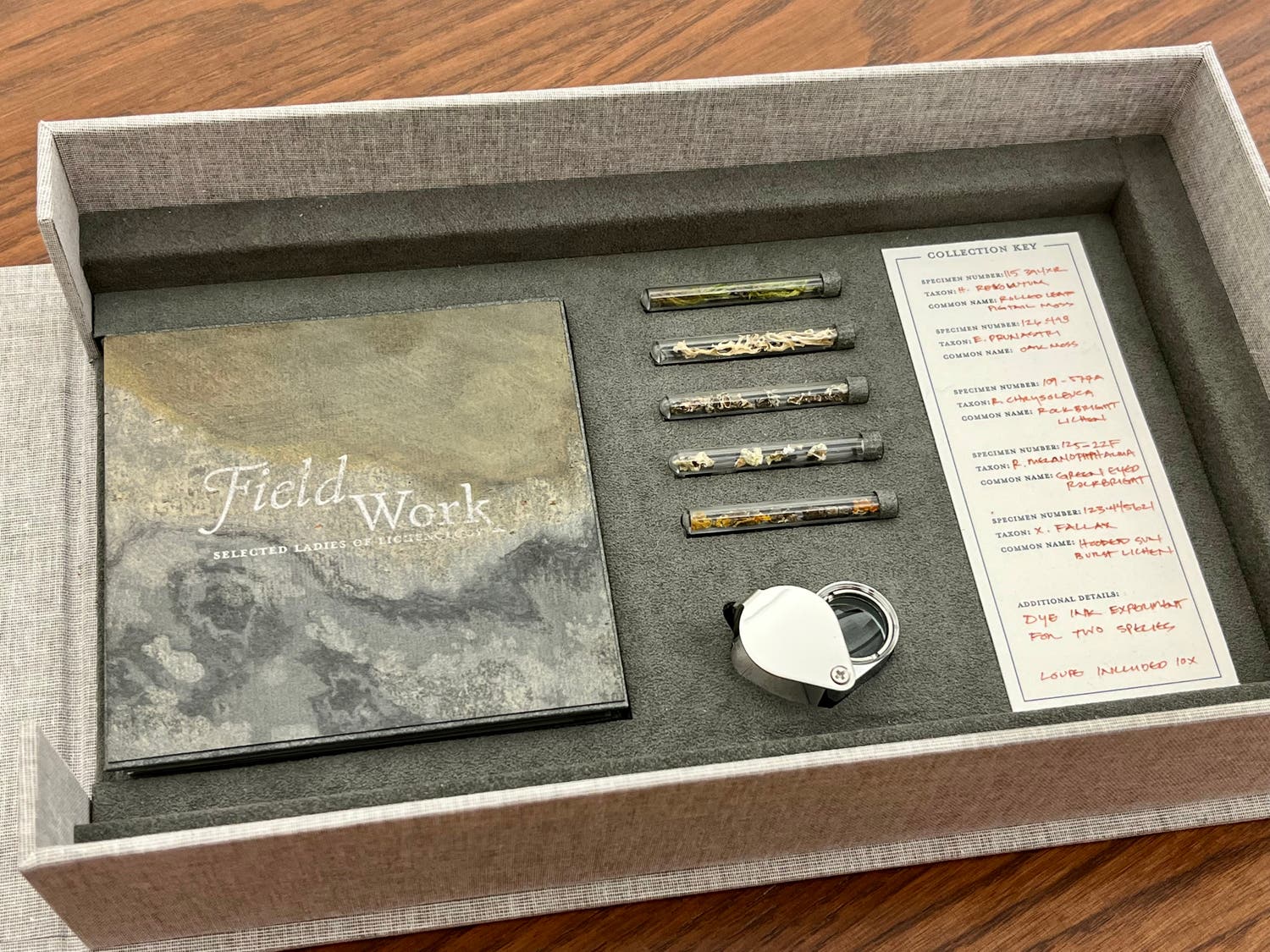
Preserved specimens of lichen and moss in glass vials and the small accordion book FieldWork, by Rhiannon Alpers.
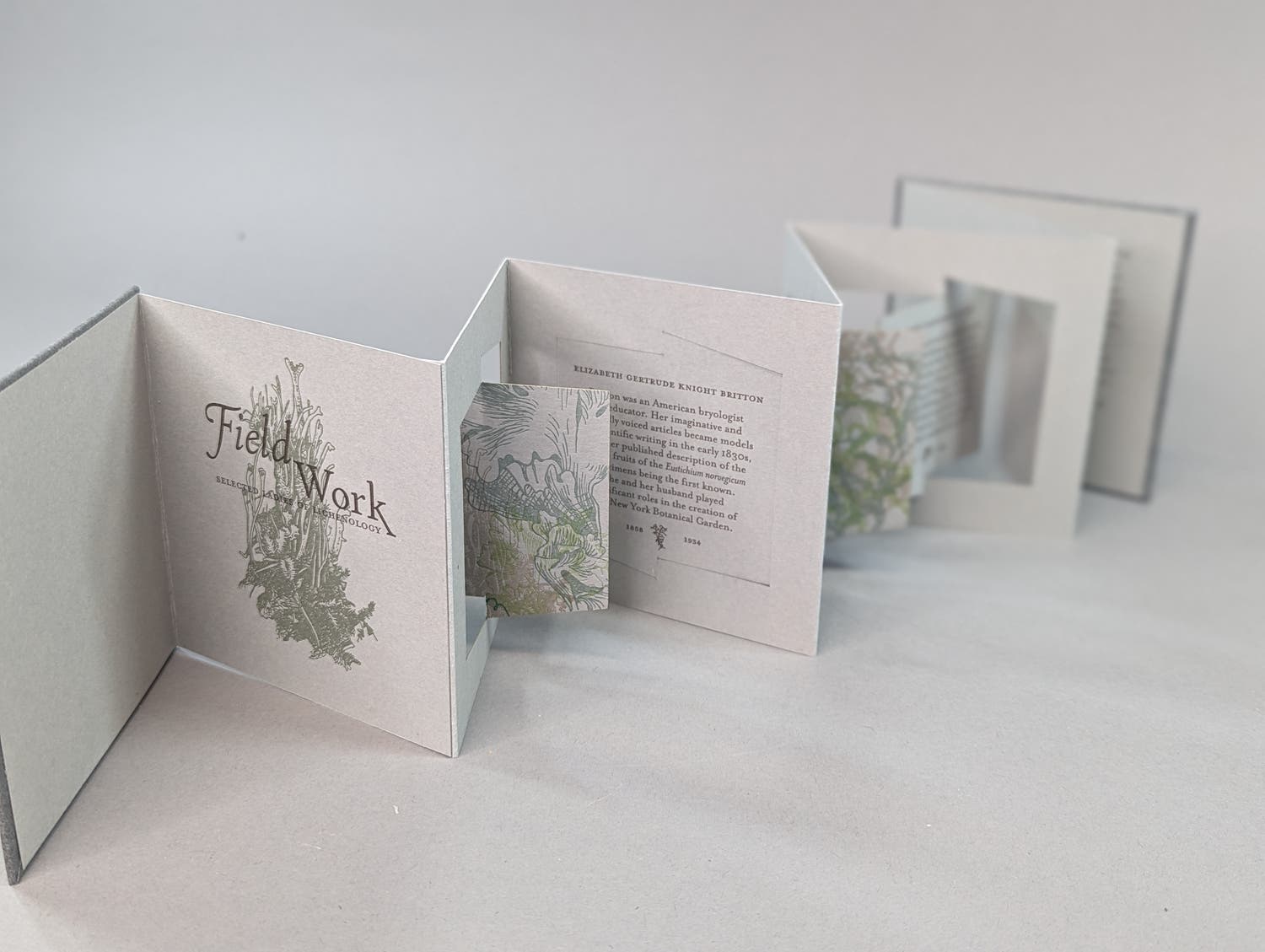
Alpers’ book FieldWork features biographies of the 20th-century naturalists Mary Farnham Miller, Elizabeth Gertrude Knight Britton, Matilda Knowles, and Elizabeth C. Wright. Each biography is paired with layered silhouette imagery of the species the women researched and published on. Photograph courtesy of Rhiannon Alpers.
When I learned about Alpers’ book, I noticed immediate alignment with the Library’s collections and our mission of expanding the story of science. Women have been part of scientific inquiry since science began. However, their work may have gone uncredited or under-noticed. Instead, they participated in natural history explorations, recorded specimens in their surroundings, and corresponded with scientific networks.
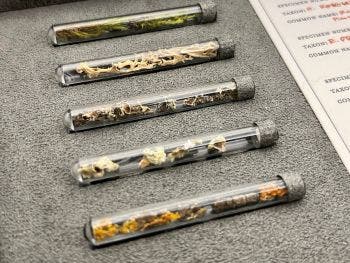
Specimens from Lichen preserved within glass vials.
The creative approaches of artists like Alpers help us recover women in the history of science and explore their full stories. Alpers’ project is also part of a long line of natural history explorations in the Western United States, including Andre Michaux and Ferdinand Hayden.
One advantage of working with modern artists’ books is that the book artists themselves are often still alive and respond to emails! For this New Acquisitions post, I had the great pleasure of interviewing Rhiannon Alpers. She was kind enough to answer my questions on her research and production process, her hopes for the book, and how her work fits with a long history of female bryologists and lichenologists.
Collins: How would you describe your research and artistic process, and where did you draw inspiration for Lichen?
Alpers: Many of my artist books originate in dreams—vivid, detailed experiences where I navigate through the books and their content with striking clarity. While the themes of my work are grounded in existing interests, these dreams spark new projects and help me refine how they will take shape.
The genesis of Lichen came from a series of dreams and a growing curiosity about the intersection between early women naturalists and the plant species of Colorado. For example, the spreads that include the mono-printed wood type of the Latin names are very close to the way they appeared in the dream—and something I worked very intensely and experimentally to reproduce.
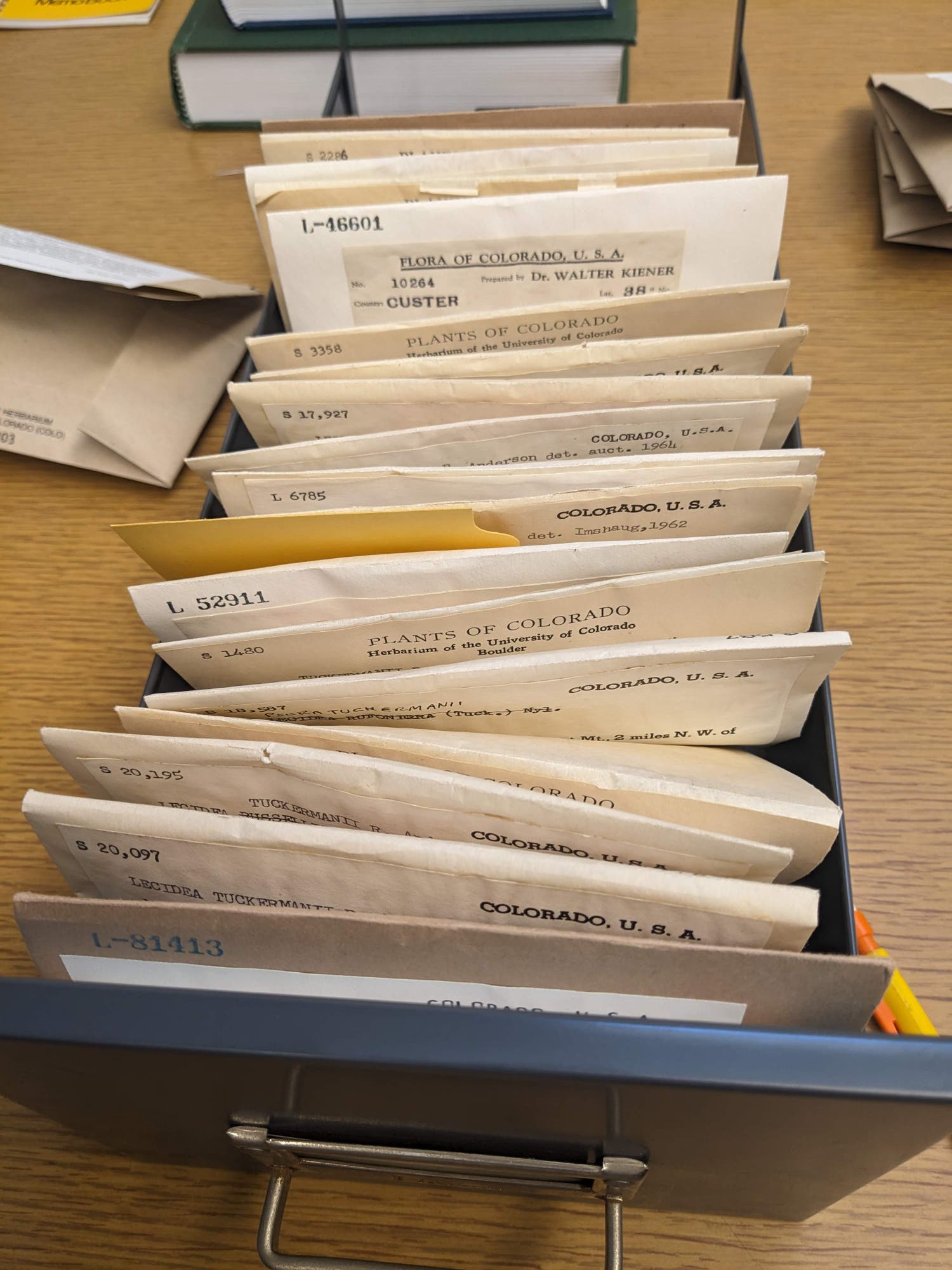
A drawer of herbarium specimens at the Colorado University COLO Herbarium in Boulder, CO. Photograph courtesy of Rhiannon Alpers.
These dreams prompted me to dive into specific areas of research and resulted in uncovering a wealth of resources within a three-hour drive from Denver—herbariums, libraries, and extensive documentation that brought this history to life. Over the following year, I explored these collections repeatedly, delving into the lives and contributions of female bryologists over the past 150 years and the herbarium specimens housed in collections.
My creative bookmaking and design process is deeply intertwined with this research. I make numerous physical models throughout the production of a book, ensuring that its form reflects and enhances the narrative I’m presenting. These models allow me to experiment with the book's structure and materials, ensuring that the final work embodies the stories and scientific discoveries I aim to share with my audience.
Collins: You’ve mentioned female bryologists as sources of inspiration for the book. Who inspired you, and how do they appear in the finished work?
Alpers: Initially, the book’s narrative and research centered on several women who made scientific and bryological contributions over the last 150 years. This research manifested into FieldWork: Ladies of Lichenology, which accompanies Lichen. FieldWork uses an accordion book format to give biographical stories about inspiring women in the field. This book highlights the contributions of Mary Farnham Miller, Elizabeth Gertrude Knight Britton, Matilda Knowles, and Elizabeth C. Wright.
During my research, I also found inspiration in the lives of Frances Elizabeth “Fanny” Tripp, Erin Anne Tripp, Mary Kathyrn Brandegee, Clara Cummings, and Alice Eastwood. While their narratives did not provide a cohesive thread for the central arc of the main Lichen book, they fueled fascinating rabbit holes into their lives and the evolution of bryology over this period. Small details from their stories appear throughout the books, enriching the broader context of the field’s history.
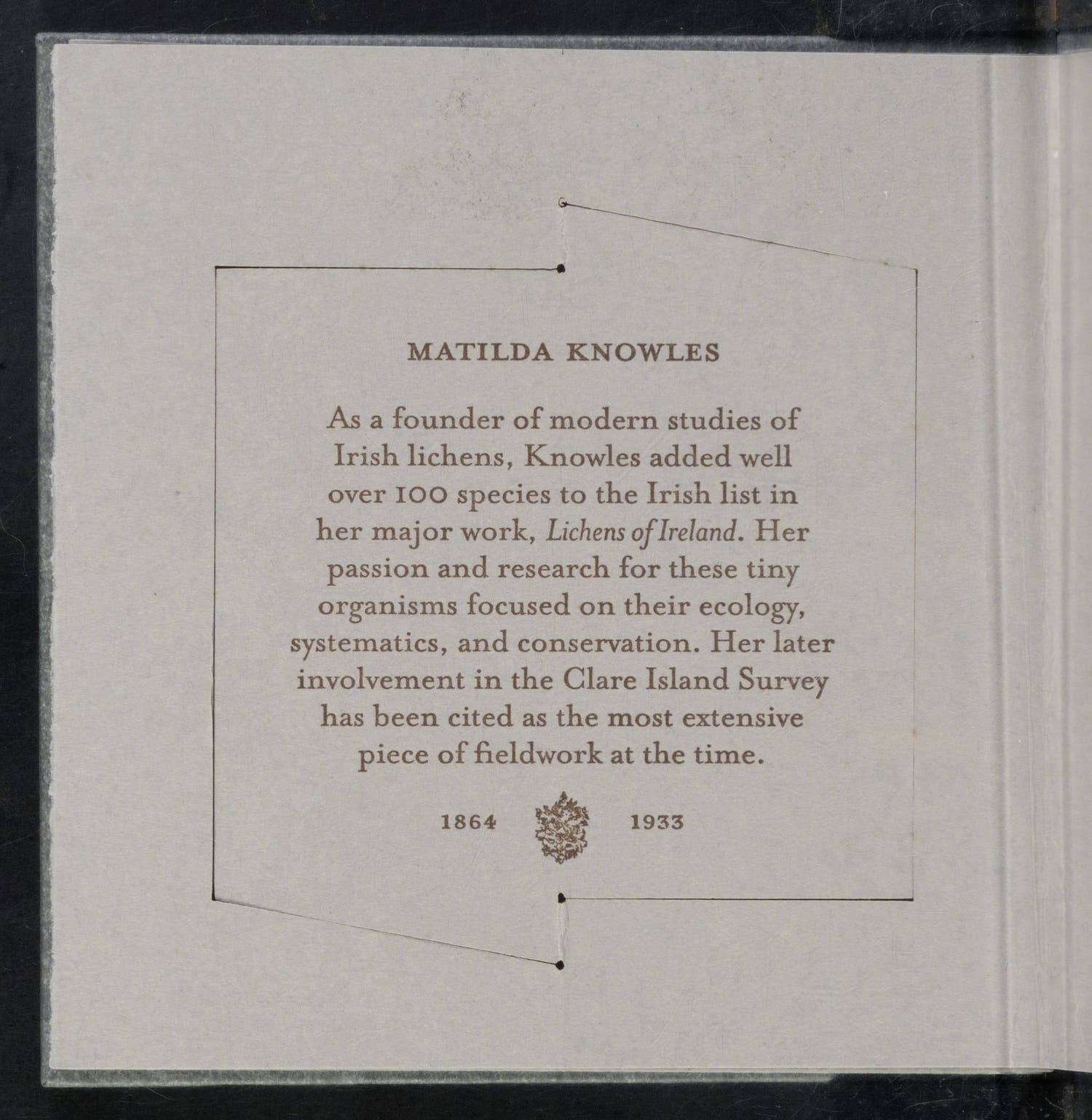
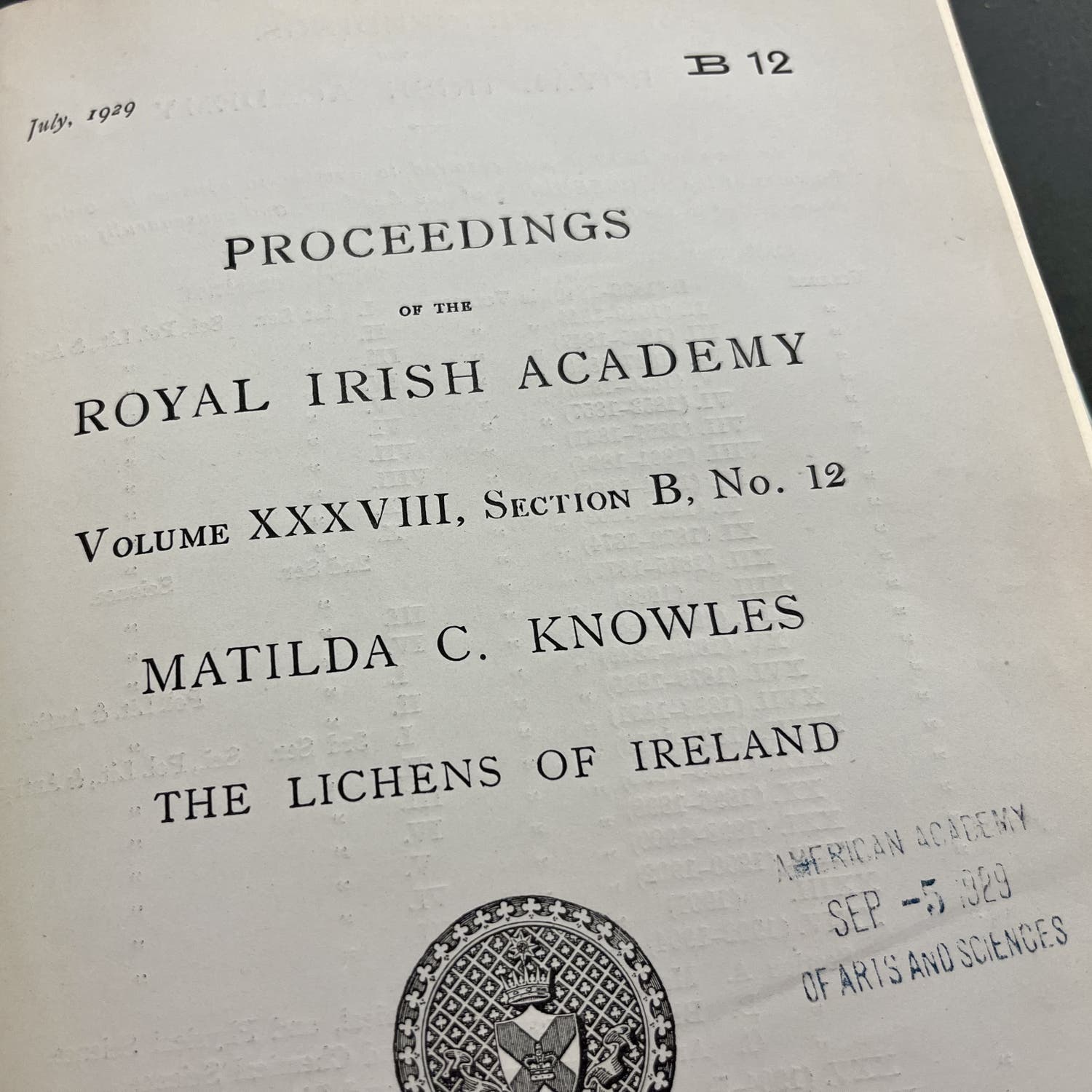
The biography of Matilda C. Knowles, who also shared curatorship of the dried and pressed plant samples at the National Museum of Ireland herbarium, adds new context to the Linda Hall Library copy of Lichens of Ireland (published as volume 38 of Proceedings of the Royal Irish Academy, Section B, in 1929).
Collins: At Linda Hall Library, Lichen will join a host of fine press and artists’ books that address science and the natural world in a larger collection of books and serials on science, engineering, and technology. We’re certainly not the first library to own a copy of your work, but I’d like to think we’re a bit unique.
Alpers: This is amazing to hear and is exactly the home I hope for when the books go off into the world of academic special collections. Linda Hall Library is a unique and inspiring home for the book. Lichen has also been acquired by collections such as the LuEsther T. Mertz Library Special Collections of the New York Botanical Garden, where the world of art and science can intermingle.
I find it wonderfully fitting that the production of this book represents a convergence of engineering, technology, and science. My artist books combine antiquated and contemporary technologies, blending software like Adobe Creative Suite and Lightburn with online herbarium and photo databases from around the world. These digital tools contrast with traditional methods, such as creating photopolymer plates for letterpress, printing on a Vandercook SP15, crafting handmade paper, and using antiquated hand tools for the bookbinding process.
The low-tech, science-based techniques of monoprinted letterpress wood type and watercolor painting—referencing the documentation methods of early explorers and naturalists—further bridge past and present. The clamshell box, multi-level tray pieces, and various book components were digitally designed, modeled, and precision-cut using my studio’s Omnitech laser cutter and then combined by hand for the edition. Boxmaking in particular merges engineering and mathematical precision along with the craft of making, offering a creative challenge to design innovative structures that house the artist books and specimens in engaging and functional ways.
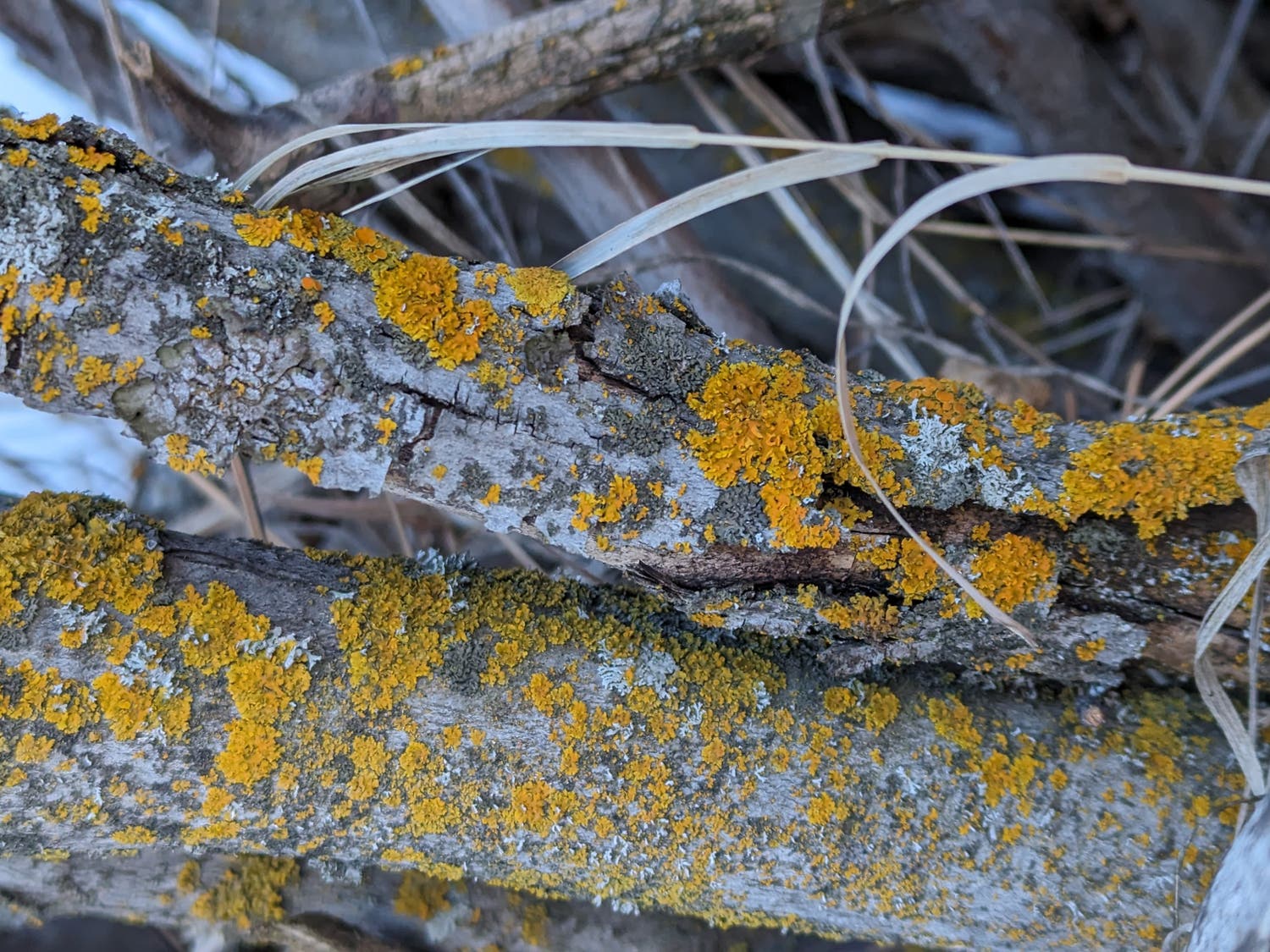
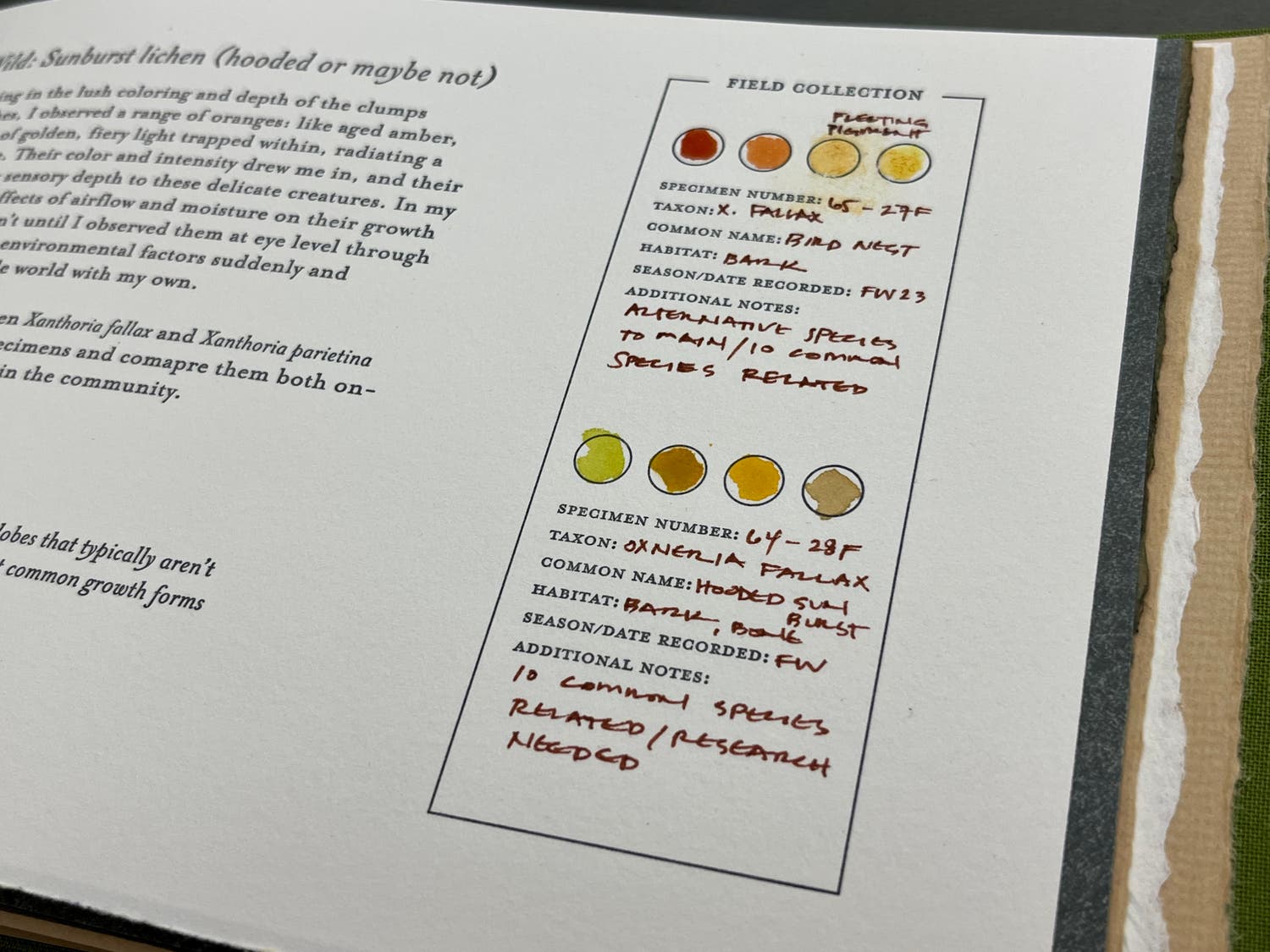
Xanthoria fallax, hooded sunburst lichen, as photographed by Alpers on a lichen-hunting trip and with color samples illustrated through watercolors, inks, and natural pigments. Photograph of lichen courtesy of Rhiannon Alpers.
Collins: How do you hope people will approach the book?
Alpers: I aim for the reading experience to feel like a journey—one that engages the audience visually, tactically, and intellectually. My books invite creative interpretation as they intertwine my reflections, specimen findings, and the discoveries of early women naturalists. Their journeys echo the scientific processes of unfolding, unearthing, and untangling, which similarly shape the act of creating and reading artist books.
For me, artist books are a medium uniquely suited to multidimensional storytelling, offering the audience an experience that is both sequential and spatial. These works incorporate handmade paper, bookbinding, macro-photography, laser cutting, digital and letterpress printing, and physical specimens, all bound together by a unifying narrative concept. I am excited and pleased when readers are intrigued by the language the materials “speak” in the artwork – and when it speaks to them as well.
It is important to me that these stories and their scientific contexts remain accessible to a broad audience, regardless of background. The layered combination of color, texture, data, mapping, storytelling, and material invites viewers to connect with the work in their own way—whether they are drawn to its visual elements, tactile qualities, or the deeper narrative threads of history and science.
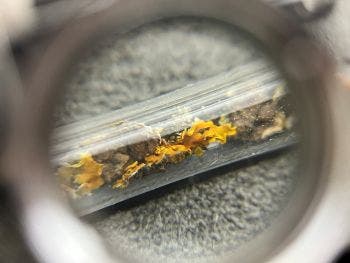
X. fallax sample viewed through the loupe.
This artist book and its sculptural clamshell box, like many of my previous editions, draw inspiration from the history and visual sensibility of cabinets of curiosities and the pioneering women in science. Through first-hand experiences and reframed historical narratives, I attempt to illuminate the contributions of early women naturalists, intertwining their perspectives with their scientific documentation. I hope that people can identify the influences, or at the very least see a connection.
A huge thanks is due to Rhiannon Alpers for her generous spirit, her thoughtful interview, and some of the excellent photographs featured here. You can find out more about her press, exhibitions, and workshops on her website.
If you’re interested in seeing Lichen: Rambles in the Colorado Front Range, it may be on display in the summer of 2025; until then, the book has been scanned by our exemplary team in the Digital Initiatives Unit. You can also check out a modern edition of Lichen Tufts: From the Alleghanies by Elizabeth C. Wright, one of the lichenologists featured in Alpers’ FieldWork, or A. Laurie Palmer’s The Lichen Museum from the 1st floor Casual Reading Collection. I’ll be taking a leaf out of Alpers’ book and, as I walk around Kansas City, keep my eyes peeled for lichen.

